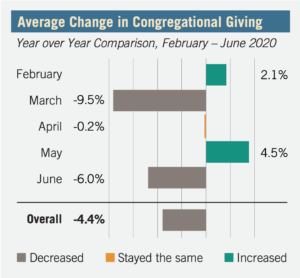Fall is a traditional season for budget planning in many churches and denominations, with stewardship drives often following into the holidays, but COVID-19 has flattened expectations and heightened uncertainty, according to a new survey conducted by the Lake Institute on Faith and Giving.
The institute, a program of Indiana University’s Lilly Family School of Philanthropy, surveyed 555 U.S. congregations in July about how they fared in the early months of the pandemic and their plans for the coming year. Respondents represent a wide diversity of congregations across a variety of religious traditions.
None of the congregations surveyed expected to increase its budget during the next year. The majority (52%) plan to maintain their current budgets, while 48% anticipate reductions, with most of those anticipating cuts in the 5% to 10% range.
This comes after overall congregational giving declined by 4.4% on average from February through June 2020 compared to the same period in 2019, the survey found. A plurality of congregations (41%) reported a decrease in giving, while more than a quarter (28%) said giving increased.

David King
“Most congregations stopped in-person religious services in mid-March, quickly shifting online, and they’ve had to navigate uncertainty in multiple aspects of congregational life and operations ever since,” said David King, director of the institute. “As congregations consider when and how to reopen while planning for their financial futures, they are asking themselves important questions about what comes next.”
Key findings from the survey that are highlighted by the institute include:
- While a majority (52%) of congregations reported an increase in participation, a plurality (41%) experienced a decrease in giving.
- Catholic parishes and small congregations (fewer than 50 weekly participants) reported declines in participation and giving more often than any other group.
- 65% of congregations surveyed received federal Payroll Protection Program loans. Just 14% of all congregations reported having to make reductions, layoffs or furloughs of staff.
- 30% of congregations raised funds to support other congregations and nonprofits in need.
- Just over half (53%) of congregations reported they already had resumed in-person services or anticipated doing so by Sept. 1. One-third of congregations indicated they did not know when they would reopen.
- Congregations’ political orientations appear to have a greater effect on reopening than do public health or financial considerations. Nearly three-quarters (71%) of conservative congregations had reopened or planned to reopen by August for in-person religious services, compared to 20% of liberal congregations and 49% of moderates.
- Congregations that continue to face a financial shortfall going forward plan to continue to reduce administrative expenses while developing new fundraising appeals and drawing down from their financial reserves or endowment.
King said the fact that most congregations plan to maintain their current budgets next year or reduce them by a small percentage probably indicates some “paralysis” in decision making without a lot of information.
King said the fact that most congregations plan to maintain their current budgets next year or reduce them by a small percentage probably indicates some “paralysis” in decision making without a lot of information.
“But maintaining budgets in a year like this — sustaining your giving or sustaining your budget — really is a glass-half-full outcome in many ways,” he said.
King said there are similarities to the experiences of congregations and nonprofits during the pandemic, especially those working in social services. Both saw an influx of funds during the early months of the pandemic but also a dramatic rise in the need for their services.
“For both nonprofits and congregations, I think the worry is, ‘What will happen over the next six months if we’re going to continue with the pandemic similar to now?’ There’s a little bit of fatigue for donors to nonprofits and increasing uncertainty with an election coming and with economic uncertainty,” he explained.
 King said that while the survey is reflective of 555 complete responses from congregations, hundreds more gave good information.
King said that while the survey is reflective of 555 complete responses from congregations, hundreds more gave good information.
“We are grateful for that response because we asked a lot of congregational leaders at a time when a lot is being asked of them,” he said. “Congregations were really very honest with us. Not only did we ask questions about whether their giving was up or down, but we asked specific questions about the exact financial amount that they received in the spring and in various months.”
King said this level of response helps the institute fulfill its mission of tying research to education and practices.
“Our hope is to be able to give back and offer the best information to help add context and clarity to what’s happening to congregations, so they don’t feel isolated and alone,” he said. “Demonstrating what’s happening across the landscape of congregations is a helpful tool for congregations to have as they’re reflecting on their own practices.”
Find the full survey results here.

Related articles:
As major employers, churches help the economy with PPP loans
Congregations on mission and online doing better financially amid COVID


